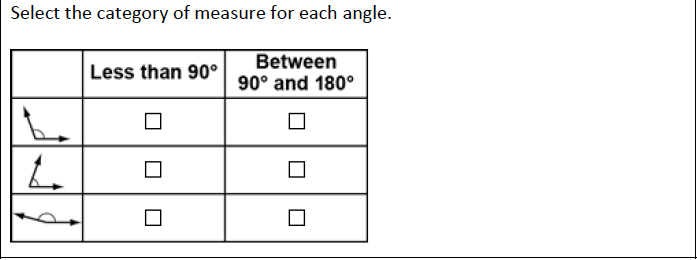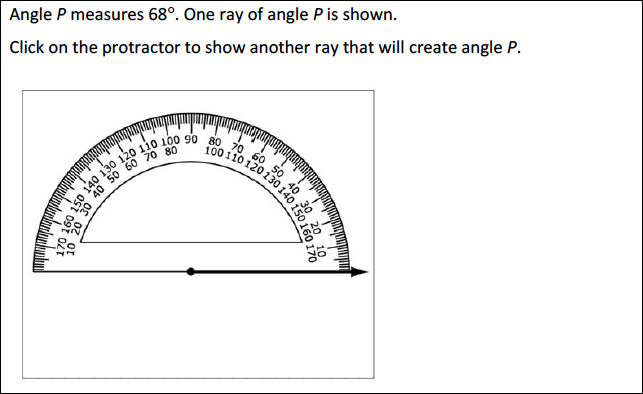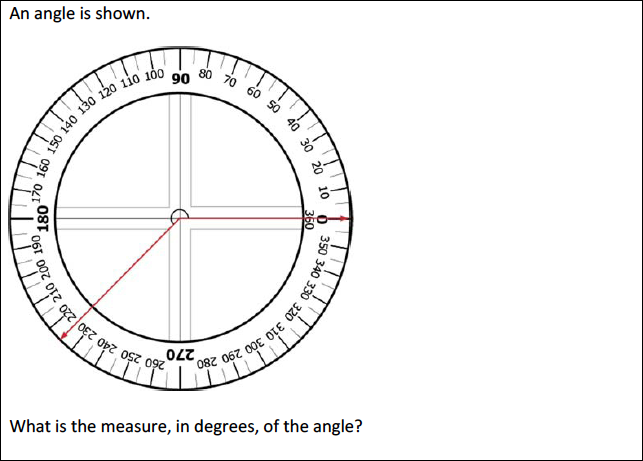Recognize angles as geometric shapes that are formed wherever two rays share a common endpoint, and understand concepts of angle measurement:
a. An angle is measured with reference to a circle with its center at the common endpoint of the rays, by considering the fraction of the circular arc between the points where the two rays intersect the circle. An angle that turns through 1/360 of a circle is called a “one-degree angle,” and can be used to measure angles.
b. An angle that turns through n one-degree angles is said to have an angle measure of n degrees.
[divider] [/divider]Students are able to…
- Describe angles with special names (obtuse, right, acute) based on their degree of measure.
- Explain that one rotation around a circle is 360˚.
- Apply understanding of fractions to a circle to relate common angles to degrees.
[divider] [/divider]Students are able to…because teachers:
- Provide opportunities for students to build and identify angles based on their relative size.
- Pose tasks in which students partition a circle and connect the division of 360˚ by that number of equal parts.
- Make connections to real life examples.
[divider] [/divider]Questions to ask students
- Point to an obtuse angle. What kind of angle it is and how do you know? (continue process with an acute and right angle)
- Sample answer that indicates understanding: That is an obtuse angle. I know because a 90˚ angle is ¼ of a turn, but this is more than that.
- Sample answer that indicates an incomplete understanding or a misconception: It’s obtuse because it is big.
- How does a right angle help you determine if the angle is acute or obtuse? Explain.
- Sample answer that indicates understanding: I know if the angle is smaller in size than the right or “square” angle, it measures less than 90 degrees or is an acute angle. I know if the angle is greater in size than the right “square” angle, it measures more than 90 degrees or is an obtuse angle.
- Draw a circle and partition it into 8 equal parts. Describe how many degrees each fractional part would measure. How do you know?
- Sample answer that indicates understanding: I know that a full circle is 360˚. If we divide that into 4 parts, each part measures 90˚. For 8 equal parts I would have to split each 90˚ piece in half. That means each eighth of the circle would be equal to 45˚.
[divider] [/divider]FSA Notes
Cognitive Complexity Level: 1 – Recall
Achievement Level Descriptors
2- recognizes angles as geometric shapes; recognizes angle measures with reference to a circle
3- measures angles using a protractor up to 180 degrees; sketches angles of specified measure
4- measures and identifies angles between 180 and 360 degrees
5- [intentionally left blank]
Assessment Limits
Items may contain whole number degree measures within 0° and 360°.
For identification, angles are less than 360°.
For construction, angles are less than 180°.
Items may not require estimating the exact measures of angles.
[divider] [/divider]Additional Resources
Additional in depth content knowledge
Video: Measure an angle using fractions of a circle
[divider] [/divider]Sample Formative Assessment Tasks:
Resources/Tasks to Help Your Child at Home
Identify angles in the real-world environment: as you are in your home, driving, at a store… look for examples of acute, right and obtuse angles. Extend to have your child record and draw the examples of each angle found.
Khan Academy: Acute, Right and Obtuse Angles https://goo.gl/Hp45BT
Khan Academy: Drawing Acute, Right and Obtuse Angles https://goo.gl/WZNT7h
Angle Game – https://goo.gl/5Xjkwh
Fold to identify angles using a circle piece of paper. Knowing that the whole circle is 360°, if I fold it in half what is the measure of each angle? (180°) Continue with folding the circle in fourths (90°), eighths (40°), etc.
Khan Academy: Angle Measurement & Circles https://goo.gl/ASFw5b




